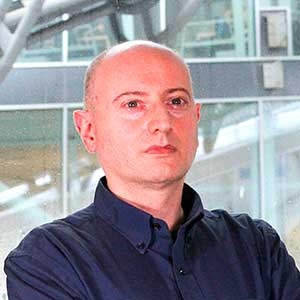Albino Zamboni
27 ottobre 2022 - SESSIONE 4 |BIG DATA, PROBLEMI E SOLUZIONI
Human Technopole – dalla fase di startup all’evoluzione verso un'infrastruttura di ricerca su larga scala
Human Technopole - from startup phase to evolution towards a large-scale research infrastructure

Human Technopole – dalla fase di startup all’evoluzione verso un'infrastruttura di ricerca su larga scala
 Laurea in Scienze dell'Informazione, Università degli Studi, Milano
Tesi: "ATM LAN emulation protocol: stato dell’arte" TF-TEN (Task Force Trans European Network) project I.N.F.N - 1997
Laurea in Scienze dell'Informazione, Università degli Studi, Milano
Tesi: "ATM LAN emulation protocol: stato dell’arte" TF-TEN (Task Force Trans European Network) project I.N.F.N - 1997
Fondazione Human Technopole
IT Network Architect - Dal 2021
ING Bank Italy
IT Network & Security Architect - Dal 2010 al 2021
ITALTEL SpA
IP/ATM Solution Engineer - Dal 2000 al 2010
ATEL GFI s.r.l
Network/System Engineer - Dal 1997 al 2010
 Computer Science degree, Università degli Studi, Milano
Thesis: "ATM LAN emulation protocol: state of the art" TF-TEN (Task Force Trans European Network) at I.N.F.N - 1997
Computer Science degree, Università degli Studi, Milano
Thesis: "ATM LAN emulation protocol: state of the art" TF-TEN (Task Force Trans European Network) at I.N.F.N - 1997
Fondazione Human Technopole
IT Network Architect - From 2021
ING Bank Italy
IT Network & Security Architect - From 2010 to 2021
ITALTEL SpA
IP/ATM/Frame Relay Solution Engineer - From 2000 to 2010
ATEL GFI s.r.l
Network/System Engineer - From 1997 to 2010
ABSTRACT
 La nuova generazione di sequenziatori di DNA, microscopi elettronici di Crio-Microscopia richiedono una elevata capacità di throughput e spazio di archiviazione, così come l’elaborazione avanzata delle immagini catturate di microscopi elettronici richiedono potenze computazionali elevate da parte di infrastrutture HPC e VDI High-GPU. Questa elevata quantità di dati può essere inoltre condivisa con altri istituti di ricerca italiani ed esteri, da qui la necessità di ridurre i tempi di transfer sugli accessi Internet e GARR. Un aspetto particolare va riservato anche alla sicurezza, in quanto alcune tipologie di dati scientifici sono tutelati dalle normative privacy e gli accessi Internet ad alta velocità posso diventare un’arma per eventuali attacchi DDoS volumetrici.
La nuova generazione di sequenziatori di DNA, microscopi elettronici di Crio-Microscopia richiedono una elevata capacità di throughput e spazio di archiviazione, così come l’elaborazione avanzata delle immagini catturate di microscopi elettronici richiedono potenze computazionali elevate da parte di infrastrutture HPC e VDI High-GPU. Questa elevata quantità di dati può essere inoltre condivisa con altri istituti di ricerca italiani ed esteri, da qui la necessità di ridurre i tempi di transfer sugli accessi Internet e GARR. Un aspetto particolare va riservato anche alla sicurezza, in quanto alcune tipologie di dati scientifici sono tutelati dalle normative privacy e gli accessi Internet ad alta velocità posso diventare un’arma per eventuali attacchi DDoS volumetrici.
 The new generation of DNA sequencing, Cryo-Microscopy electron microscopes require high throughput capacity and storage space, as well as the advanced processing of captured electron microscope images require high computational power from HPC and VDI High-GPU infrastructures. This large amount of data can also be shared with other Italian and foreign research institutes, hence the need to reduce transfer times on Internet and GARR access. A special aspect must also be reserved for security, since some types of scientific data are protected by privacy regulations and high-speed Internet accesses can become a weapon for possible volumetric DDoS attacks.
The new generation of DNA sequencing, Cryo-Microscopy electron microscopes require high throughput capacity and storage space, as well as the advanced processing of captured electron microscope images require high computational power from HPC and VDI High-GPU infrastructures. This large amount of data can also be shared with other Italian and foreign research institutes, hence the need to reduce transfer times on Internet and GARR access. A special aspect must also be reserved for security, since some types of scientific data are protected by privacy regulations and high-speed Internet accesses can become a weapon for possible volumetric DDoS attacks.




